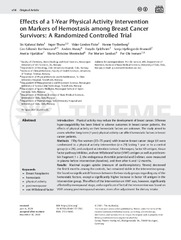Effects of a One-Year Physical Activity Intervention on Markers of Hemostasis among Breast Cancer Survivors - A Randomized Controlled Trial
Permanent link
https://hdl.handle.net/10037/35527Date
2021-02-06Type
Journal articleTidsskriftartikkel
Peer reviewed
Author
Bøhn, Siv Kjølsrud; Thune, Inger; Flote, Vidar Gordon; Frydenberg, Hanne; Bertheussen, Gro Falkener; Husøy, Anders; Fjeldheim, Frøydis Nyborg; Brunvoll, Sonja Hjellegjerde; Hjartåker, Anette; Mowinckel, Marie-Christine; Sandset, Per Morten; Iversen, Per OleAbstract
Methods - Fifty-five women (35–75 years) with invasive breast cancer stage I/II were randomized to a physical activity intervention (n = 29) lasting 1 year or to a control group (n = 26), and analyzed as intention to treat. Fibrinogen, factor VII antigen, tissue factor pathway inhibitor, and von Willebrand factor (VWF) antigen as well as prothrombin fragment 1 + 2, the endogenous thrombin potential and D-dimer, were measured in plasma before intervention (baseline), and then after 6 and 12 months.
Results - Maximal oxygen uptake (measure of cardiorespiratory fitness) decreased the first 6 months among the controls, but remained stable in the intervention group. We found no significant differences between the two study groups regarding any of the hemostatic factors, except a significantly higher increase in factor VII antigen in the intervention group. The effect of the intervention on VWF was, however, significantly affected by menopausal stage, and a significant effect of the intervention was found on VWF among postmenopausal women, even after adjustment for dietary intake.
Conclusion - Long-term physical activity had no effect on the majority of the hemostatic factors measured, but led to increased plasma concentrations of factor VII antigen and prevented an increase in VWF concentration after breast cancer treatment in postmenopausal women. The clinical impact of these findings for risk of vascular thrombosis warrants further studies.


 English
English norsk
norsk
